Analysis of Biological Communication Systems: A Biology Report
VerifiedAdded on 2020/06/03
|8
|1573
|254
Report
AI Summary
This report provides a comprehensive overview of biological communication systems within the human body. It begins by detailing the structure of the central nervous system, including sensory, connector, and motor neurons. The report then explains how nerve impulses are transmitted along neurons, emphasizing the role of chemical transmitters in crossing synapses. It further differentiates between voluntary and reflex actions, highlighting the role of the automatic nervous system. Additionally, the report examines the effects of caffeine on the transmission of nerve impulses, concluding with a summary of key findings and a list of references including books, journals, and online sources. The report uses diagrams to visually explain the nervous system.
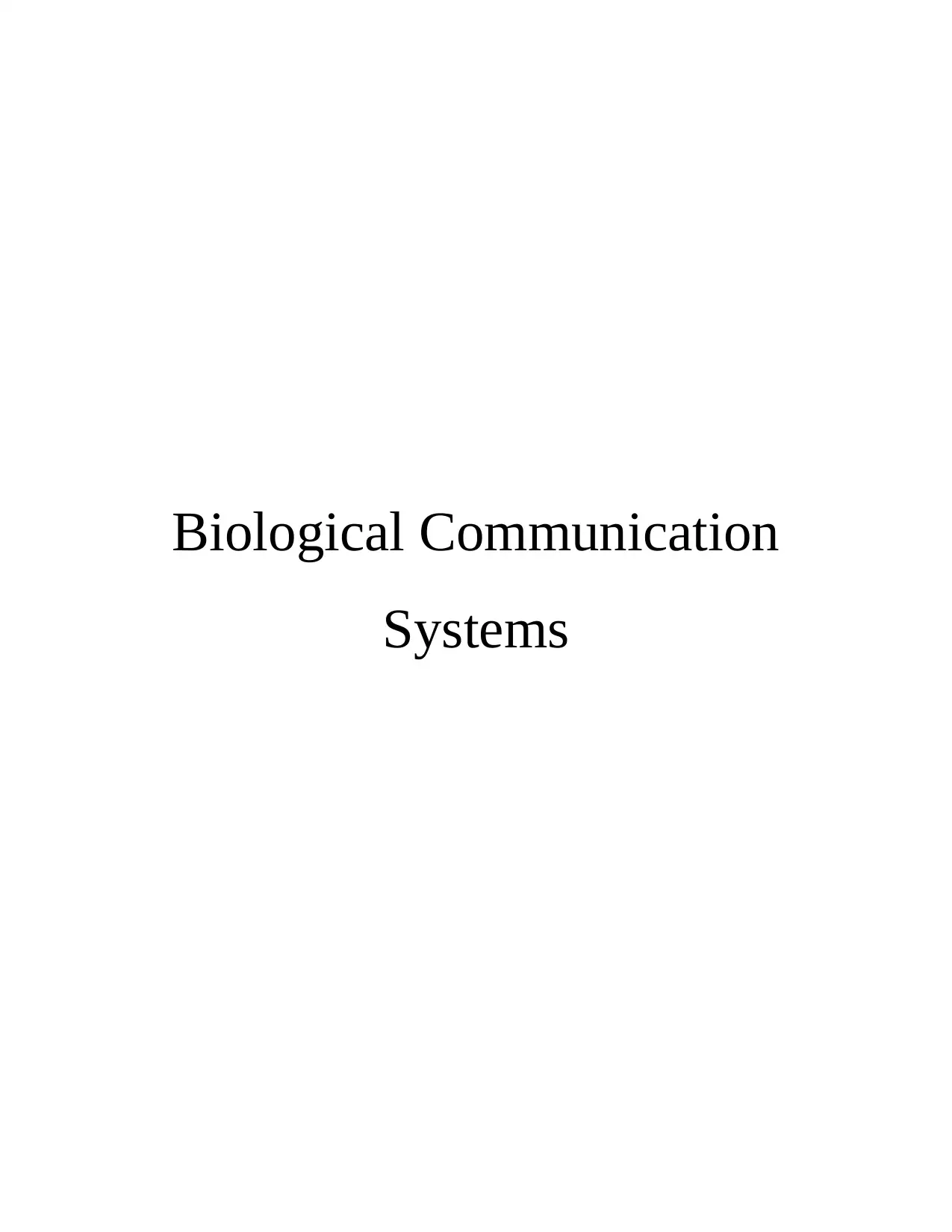
Biological Communication
Systems
Systems
Paraphrase This Document
Need a fresh take? Get an instant paraphrase of this document with our AI Paraphraser
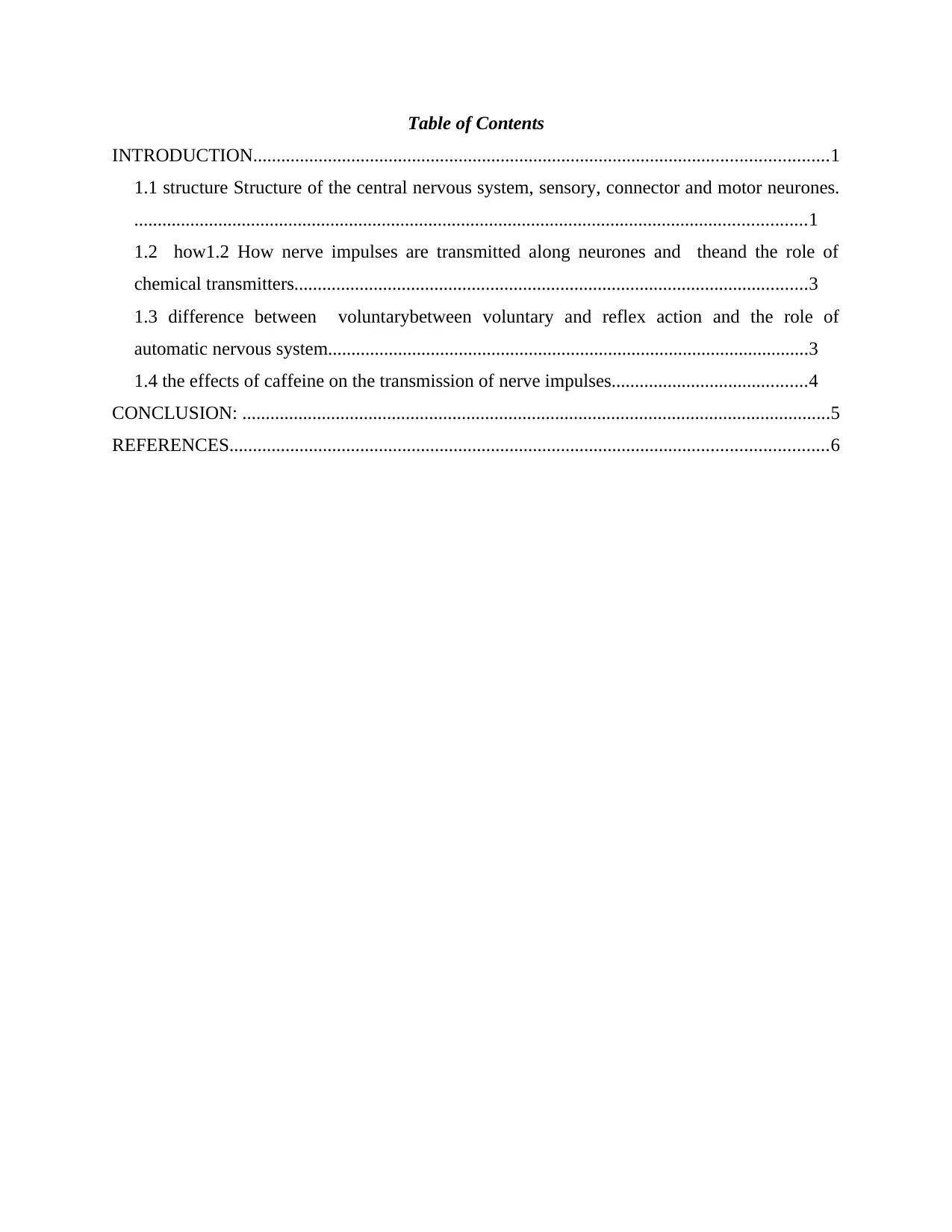
Table of Contents
INTRODUCTION...........................................................................................................................1
1.1 structure Structure of the central nervous system, sensory, connector and motor neurones.
................................................................................................................................................1
1.2 how1.2 How nerve impulses are transmitted along neurones and theand the role of
chemical transmitters..............................................................................................................3
1.3 difference between voluntarybetween voluntary and reflex action and the role of
automatic nervous system.......................................................................................................3
1.4 the effects of caffeine on the transmission of nerve impulses..........................................4
CONCLUSION: ..............................................................................................................................5
REFERENCES................................................................................................................................6
INTRODUCTION...........................................................................................................................1
1.1 structure Structure of the central nervous system, sensory, connector and motor neurones.
................................................................................................................................................1
1.2 how1.2 How nerve impulses are transmitted along neurones and theand the role of
chemical transmitters..............................................................................................................3
1.3 difference between voluntarybetween voluntary and reflex action and the role of
automatic nervous system.......................................................................................................3
1.4 the effects of caffeine on the transmission of nerve impulses..........................................4
CONCLUSION: ..............................................................................................................................5
REFERENCES................................................................................................................................6
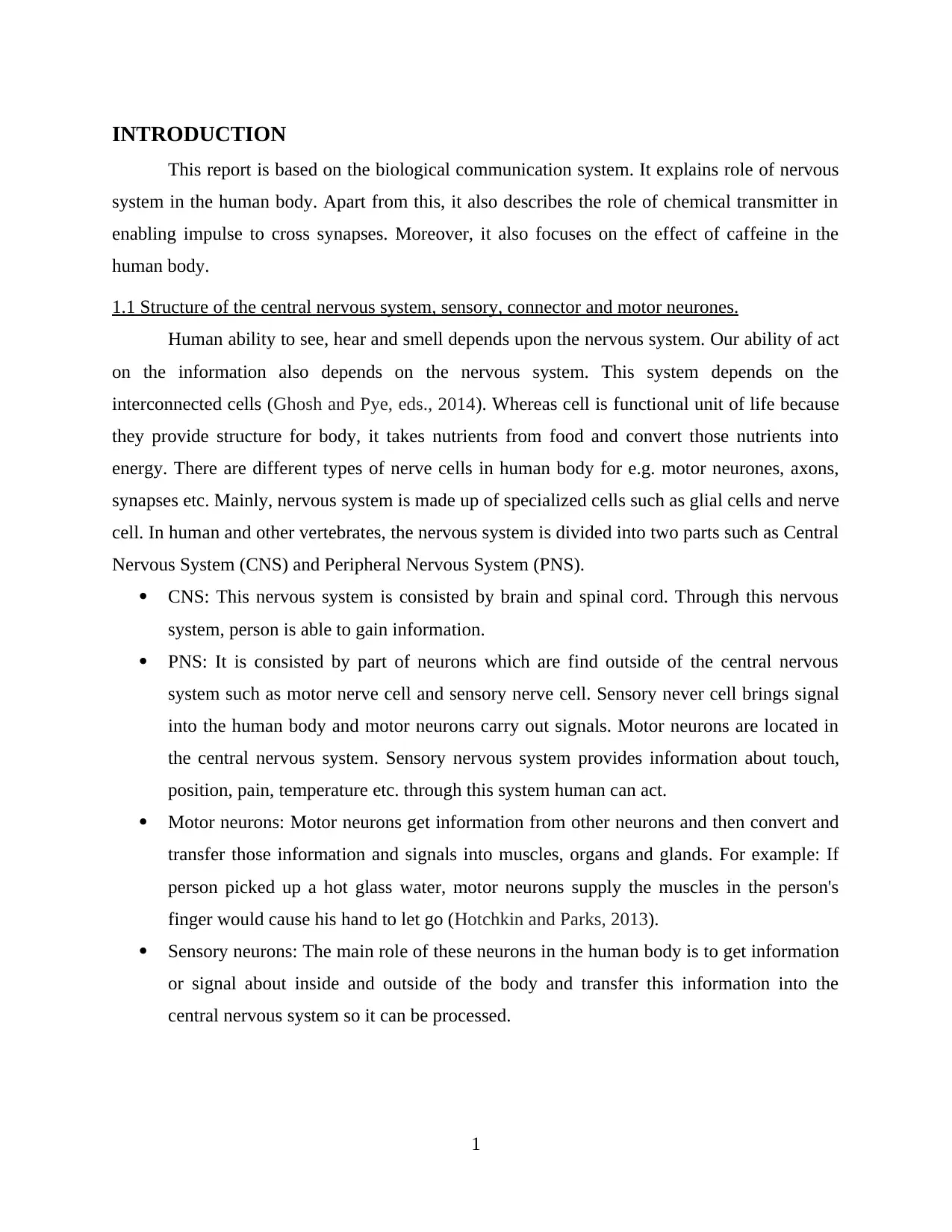
INTRODUCTION
This report is based on the biological communication system. It explains role of nervous
system in the human body. Apart from this, it also describes the role of chemical transmitter in
enabling impulse to cross synapses. Moreover, it also focuses on the effect of caffeine in the
human body.
1.1 Structure of the central nervous system, sensory, connector and motor neurones.
Human ability to see, hear and smell depends upon the nervous system. Our ability of act
on the information also depends on the nervous system. This system depends on the
interconnected cells (Ghosh and Pye, eds., 2014). Whereas cell is functional unit of life because
they provide structure for body, it takes nutrients from food and convert those nutrients into
energy. There are different types of nerve cells in human body for e.g. motor neurones, axons,
synapses etc. Mainly, nervous system is made up of specialized cells such as glial cells and nerve
cell. In human and other vertebrates, the nervous system is divided into two parts such as Central
Nervous System (CNS) and Peripheral Nervous System (PNS).
CNS: This nervous system is consisted by brain and spinal cord. Through this nervous
system, person is able to gain information.
PNS: It is consisted by part of neurons which are find outside of the central nervous
system such as motor nerve cell and sensory nerve cell. Sensory never cell brings signal
into the human body and motor neurons carry out signals. Motor neurons are located in
the central nervous system. Sensory nervous system provides information about touch,
position, pain, temperature etc. through this system human can act.
Motor neurons: Motor neurons get information from other neurons and then convert and
transfer those information and signals into muscles, organs and glands. For example: If
person picked up a hot glass water, motor neurons supply the muscles in the person's
finger would cause his hand to let go (Hotchkin and Parks, 2013).
Sensory neurons: The main role of these neurons in the human body is to get information
or signal about inside and outside of the body and transfer this information into the
central nervous system so it can be processed.
1
This report is based on the biological communication system. It explains role of nervous
system in the human body. Apart from this, it also describes the role of chemical transmitter in
enabling impulse to cross synapses. Moreover, it also focuses on the effect of caffeine in the
human body.
1.1 Structure of the central nervous system, sensory, connector and motor neurones.
Human ability to see, hear and smell depends upon the nervous system. Our ability of act
on the information also depends on the nervous system. This system depends on the
interconnected cells (Ghosh and Pye, eds., 2014). Whereas cell is functional unit of life because
they provide structure for body, it takes nutrients from food and convert those nutrients into
energy. There are different types of nerve cells in human body for e.g. motor neurones, axons,
synapses etc. Mainly, nervous system is made up of specialized cells such as glial cells and nerve
cell. In human and other vertebrates, the nervous system is divided into two parts such as Central
Nervous System (CNS) and Peripheral Nervous System (PNS).
CNS: This nervous system is consisted by brain and spinal cord. Through this nervous
system, person is able to gain information.
PNS: It is consisted by part of neurons which are find outside of the central nervous
system such as motor nerve cell and sensory nerve cell. Sensory never cell brings signal
into the human body and motor neurons carry out signals. Motor neurons are located in
the central nervous system. Sensory nervous system provides information about touch,
position, pain, temperature etc. through this system human can act.
Motor neurons: Motor neurons get information from other neurons and then convert and
transfer those information and signals into muscles, organs and glands. For example: If
person picked up a hot glass water, motor neurons supply the muscles in the person's
finger would cause his hand to let go (Hotchkin and Parks, 2013).
Sensory neurons: The main role of these neurons in the human body is to get information
or signal about inside and outside of the body and transfer this information into the
central nervous system so it can be processed.
1
⊘ This is a preview!⊘
Do you want full access?
Subscribe today to unlock all pages.

Trusted by 1+ million students worldwide
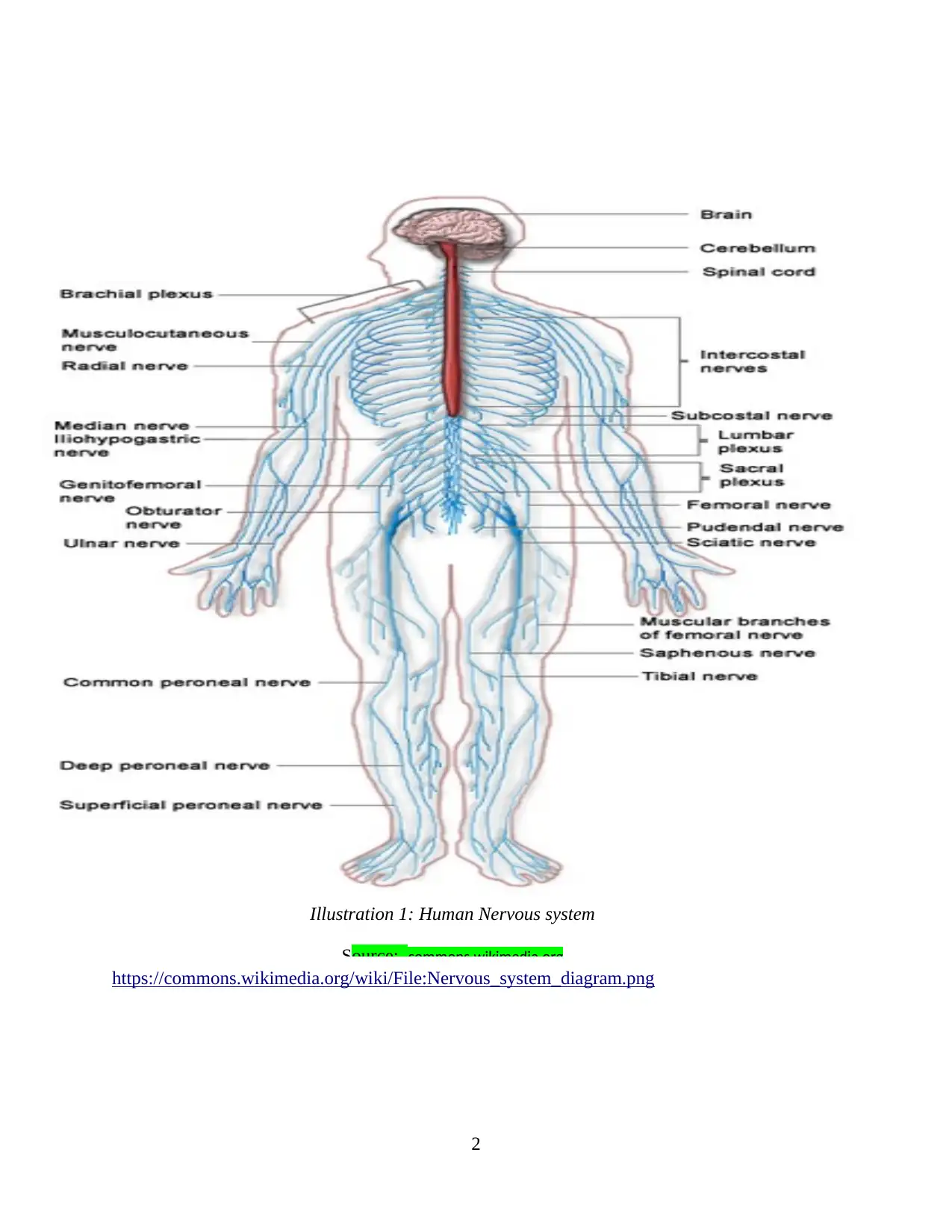
https://commons.wikimedia.org/wiki/File:Nervous_system_diagram.png
2
Illustration 1: Human Nervous system
Source: commons.wikimedia.org
2
Illustration 1: Human Nervous system
Source: commons.wikimedia.org
Paraphrase This Document
Need a fresh take? Get an instant paraphrase of this document with our AI Paraphraser
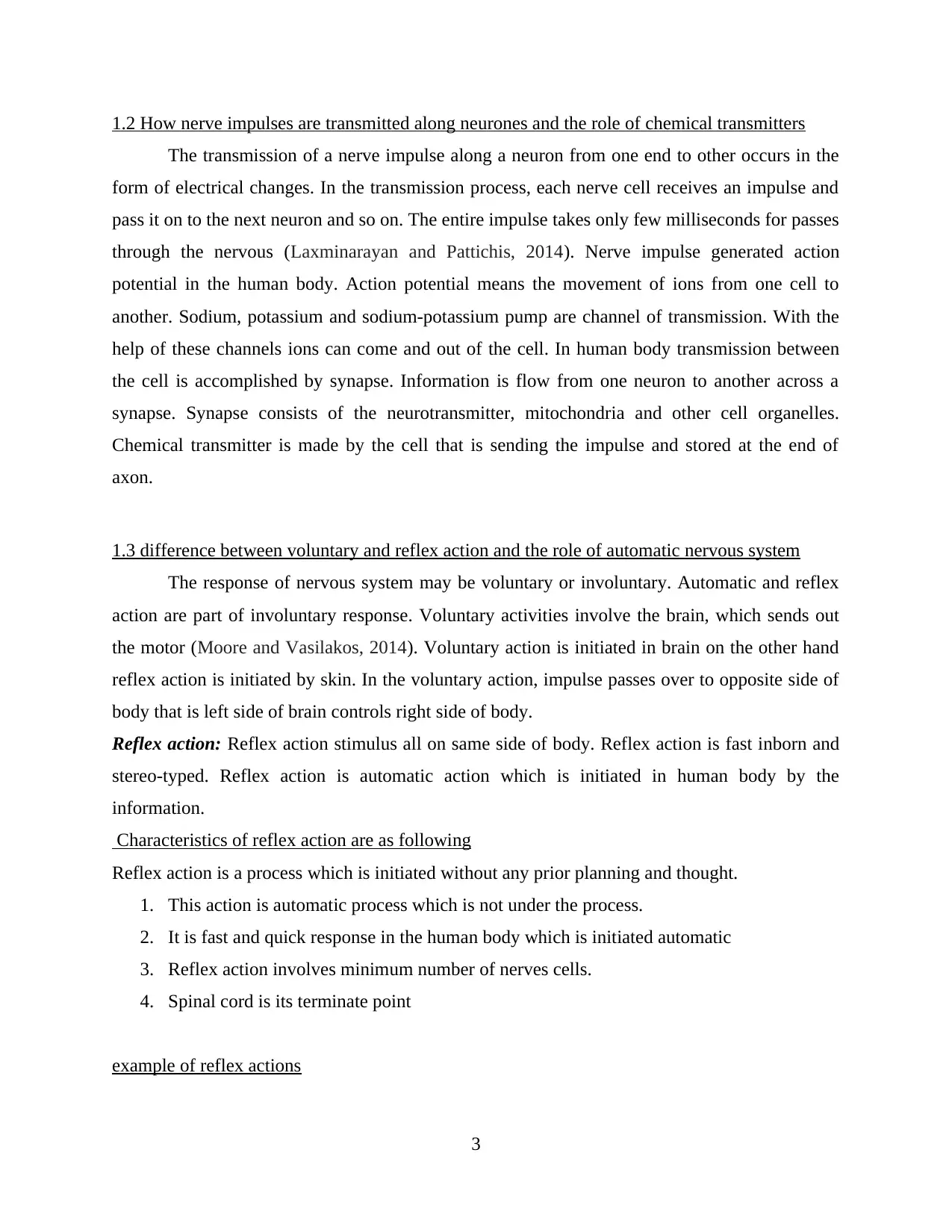
1.2 How nerve impulses are transmitted along neurones and the role of chemical transmitters
The transmission of a nerve impulse along a neuron from one end to other occurs in the
form of electrical changes. In the transmission process, each nerve cell receives an impulse and
pass it on to the next neuron and so on. The entire impulse takes only few milliseconds for passes
through the nervous (Laxminarayan and Pattichis, 2014). Nerve impulse generated action
potential in the human body. Action potential means the movement of ions from one cell to
another. Sodium, potassium and sodium-potassium pump are channel of transmission. With the
help of these channels ions can come and out of the cell. In human body transmission between
the cell is accomplished by synapse. Information is flow from one neuron to another across a
synapse. Synapse consists of the neurotransmitter, mitochondria and other cell organelles.
Chemical transmitter is made by the cell that is sending the impulse and stored at the end of
axon.
1.3 difference between voluntary and reflex action and the role of automatic nervous system
The response of nervous system may be voluntary or involuntary. Automatic and reflex
action are part of involuntary response. Voluntary activities involve the brain, which sends out
the motor (Moore and Vasilakos, 2014). Voluntary action is initiated in brain on the other hand
reflex action is initiated by skin. In the voluntary action, impulse passes over to opposite side of
body that is left side of brain controls right side of body.
Reflex action: Reflex action stimulus all on same side of body. Reflex action is fast inborn and
stereo-typed. Reflex action is automatic action which is initiated in human body by the
information.
Characteristics of reflex action are as following
Reflex action is a process which is initiated without any prior planning and thought.
1. This action is automatic process which is not under the process.
2. It is fast and quick response in the human body which is initiated automatic
3. Reflex action involves minimum number of nerves cells.
4. Spinal cord is its terminate point
example of reflex actions
3
The transmission of a nerve impulse along a neuron from one end to other occurs in the
form of electrical changes. In the transmission process, each nerve cell receives an impulse and
pass it on to the next neuron and so on. The entire impulse takes only few milliseconds for passes
through the nervous (Laxminarayan and Pattichis, 2014). Nerve impulse generated action
potential in the human body. Action potential means the movement of ions from one cell to
another. Sodium, potassium and sodium-potassium pump are channel of transmission. With the
help of these channels ions can come and out of the cell. In human body transmission between
the cell is accomplished by synapse. Information is flow from one neuron to another across a
synapse. Synapse consists of the neurotransmitter, mitochondria and other cell organelles.
Chemical transmitter is made by the cell that is sending the impulse and stored at the end of
axon.
1.3 difference between voluntary and reflex action and the role of automatic nervous system
The response of nervous system may be voluntary or involuntary. Automatic and reflex
action are part of involuntary response. Voluntary activities involve the brain, which sends out
the motor (Moore and Vasilakos, 2014). Voluntary action is initiated in brain on the other hand
reflex action is initiated by skin. In the voluntary action, impulse passes over to opposite side of
body that is left side of brain controls right side of body.
Reflex action: Reflex action stimulus all on same side of body. Reflex action is fast inborn and
stereo-typed. Reflex action is automatic action which is initiated in human body by the
information.
Characteristics of reflex action are as following
Reflex action is a process which is initiated without any prior planning and thought.
1. This action is automatic process which is not under the process.
2. It is fast and quick response in the human body which is initiated automatic
3. Reflex action involves minimum number of nerves cells.
4. Spinal cord is its terminate point
example of reflex actions
3
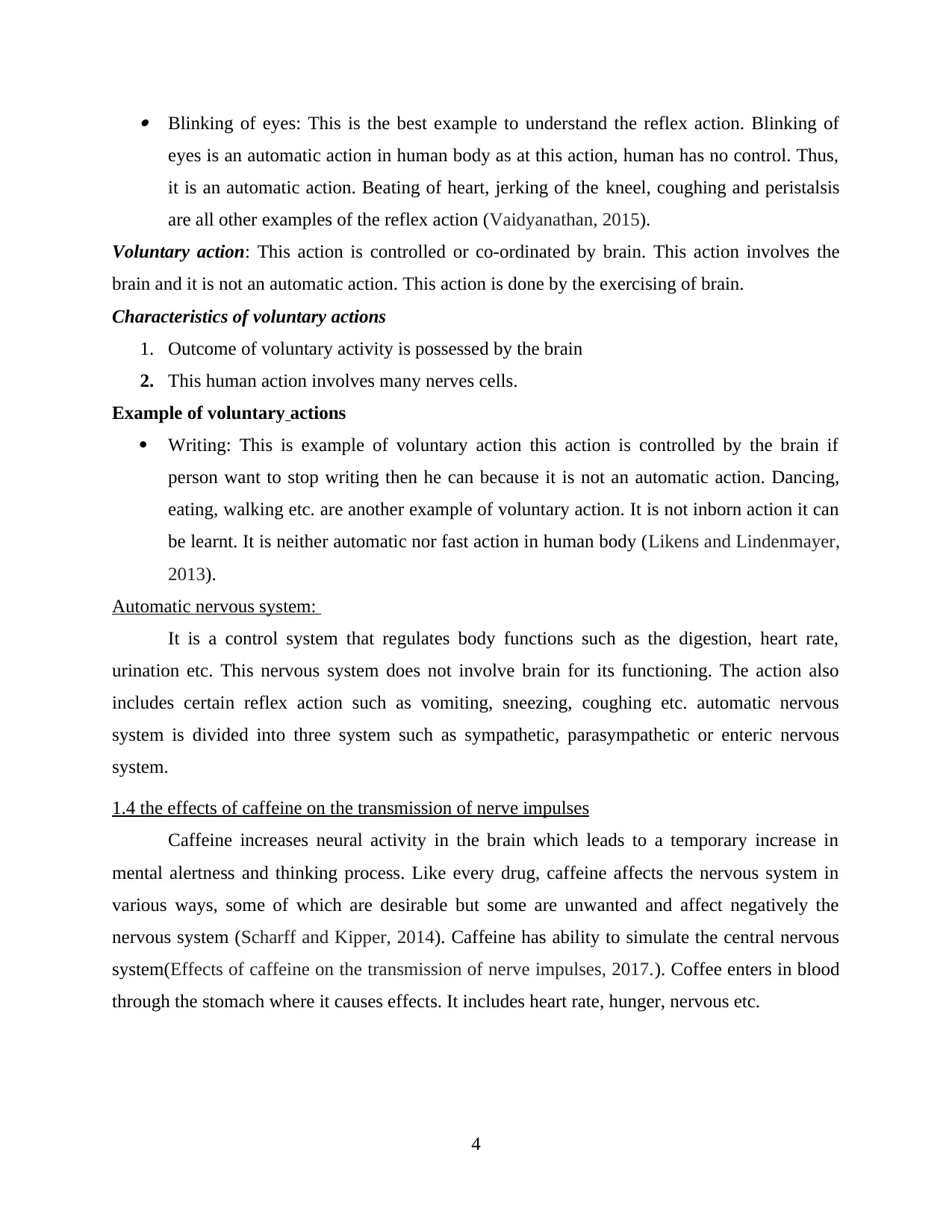
Blinking of eyes: This is the best example to understand the reflex action. Blinking of
eyes is an automatic action in human body as at this action, human has no control. Thus,
it is an automatic action. Beating of heart, jerking of the kneel, coughing and peristalsis
are all other examples of the reflex action (Vaidyanathan, 2015).
Voluntary action: This action is controlled or co-ordinated by brain. This action involves the
brain and it is not an automatic action. This action is done by the exercising of brain.
Characteristics of voluntary actions
1. Outcome of voluntary activity is possessed by the brain
2. This human action involves many nerves cells.
Example of voluntary actions
Writing: This is example of voluntary action this action is controlled by the brain if
person want to stop writing then he can because it is not an automatic action. Dancing,
eating, walking etc. are another example of voluntary action. It is not inborn action it can
be learnt. It is neither automatic nor fast action in human body (Likens and Lindenmayer,
2013).
Automatic nervous system:
It is a control system that regulates body functions such as the digestion, heart rate,
urination etc. This nervous system does not involve brain for its functioning. The action also
includes certain reflex action such as vomiting, sneezing, coughing etc. automatic nervous
system is divided into three system such as sympathetic, parasympathetic or enteric nervous
system.
1.4 the effects of caffeine on the transmission of nerve impulses
Caffeine increases neural activity in the brain which leads to a temporary increase in
mental alertness and thinking process. Like every drug, caffeine affects the nervous system in
various ways, some of which are desirable but some are unwanted and affect negatively the
nervous system (Scharff and Kipper, 2014). Caffeine has ability to simulate the central nervous
system(Effects of caffeine on the transmission of nerve impulses, 2017.). Coffee enters in blood
through the stomach where it causes effects. It includes heart rate, hunger, nervous etc.
4
eyes is an automatic action in human body as at this action, human has no control. Thus,
it is an automatic action. Beating of heart, jerking of the kneel, coughing and peristalsis
are all other examples of the reflex action (Vaidyanathan, 2015).
Voluntary action: This action is controlled or co-ordinated by brain. This action involves the
brain and it is not an automatic action. This action is done by the exercising of brain.
Characteristics of voluntary actions
1. Outcome of voluntary activity is possessed by the brain
2. This human action involves many nerves cells.
Example of voluntary actions
Writing: This is example of voluntary action this action is controlled by the brain if
person want to stop writing then he can because it is not an automatic action. Dancing,
eating, walking etc. are another example of voluntary action. It is not inborn action it can
be learnt. It is neither automatic nor fast action in human body (Likens and Lindenmayer,
2013).
Automatic nervous system:
It is a control system that regulates body functions such as the digestion, heart rate,
urination etc. This nervous system does not involve brain for its functioning. The action also
includes certain reflex action such as vomiting, sneezing, coughing etc. automatic nervous
system is divided into three system such as sympathetic, parasympathetic or enteric nervous
system.
1.4 the effects of caffeine on the transmission of nerve impulses
Caffeine increases neural activity in the brain which leads to a temporary increase in
mental alertness and thinking process. Like every drug, caffeine affects the nervous system in
various ways, some of which are desirable but some are unwanted and affect negatively the
nervous system (Scharff and Kipper, 2014). Caffeine has ability to simulate the central nervous
system(Effects of caffeine on the transmission of nerve impulses, 2017.). Coffee enters in blood
through the stomach where it causes effects. It includes heart rate, hunger, nervous etc.
4
⊘ This is a preview!⊘
Do you want full access?
Subscribe today to unlock all pages.

Trusted by 1+ million students worldwide

CONCLUSION
From the above report, it has been concluded that nervous system depends on the interconnected
cells. It also focused on the voluntary and reflex action. At the end, the report described the
effect of coffee on nervous system.
5
From the above report, it has been concluded that nervous system depends on the interconnected
cells. It also focused on the voluntary and reflex action. At the end, the report described the
effect of coffee on nervous system.
5
Paraphrase This Document
Need a fresh take? Get an instant paraphrase of this document with our AI Paraphraser
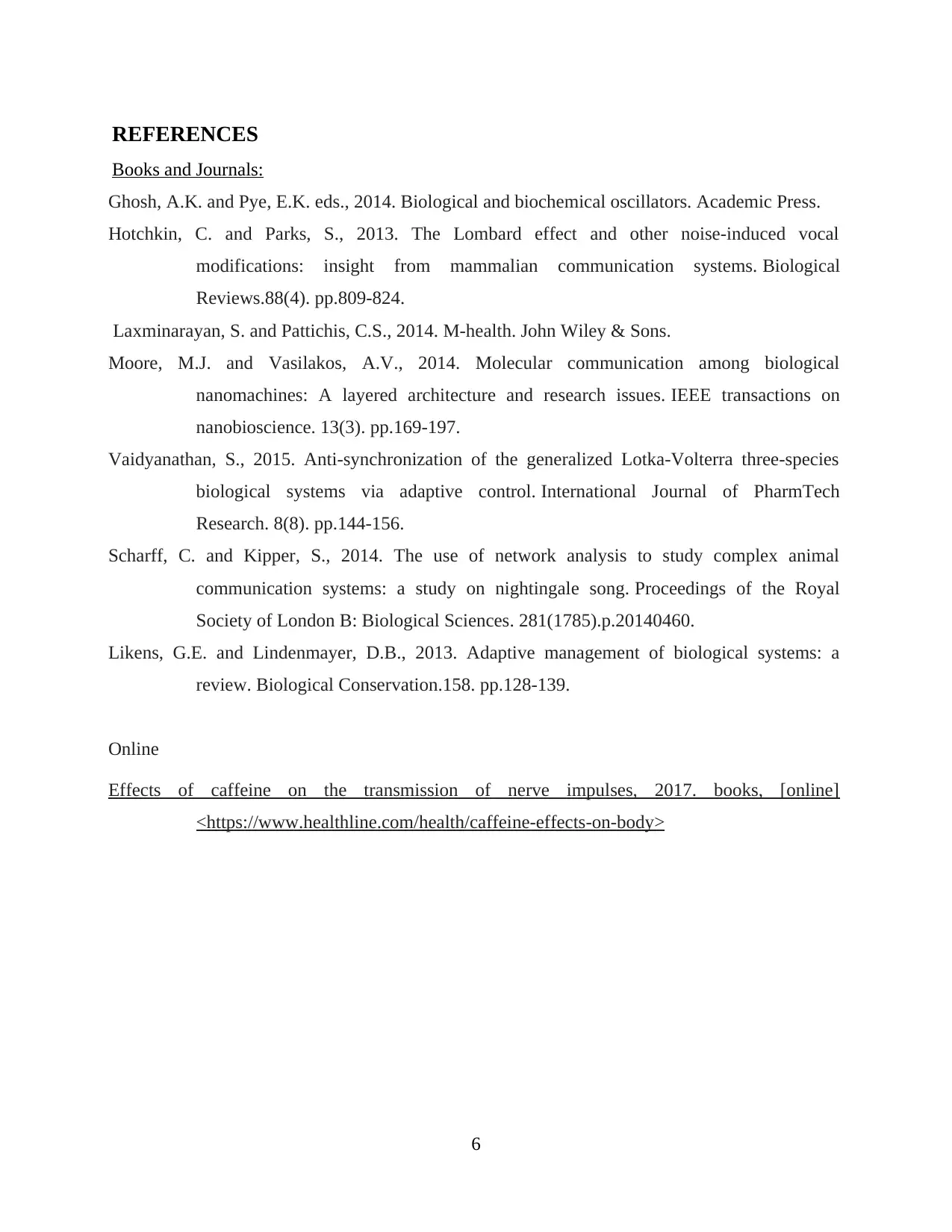
REFERENCES
Books and Journals:
Ghosh, A.K. and Pye, E.K. eds., 2014. Biological and biochemical oscillators. Academic Press.
Hotchkin, C. and Parks, S., 2013. The Lombard effect and other noise‐induced vocal
modifications: insight from mammalian communication systems. Biological
Reviews.88(4). pp.809-824.
Laxminarayan, S. and Pattichis, C.S., 2014. M-health. John Wiley & Sons.
Moore, M.J. and Vasilakos, A.V., 2014. Molecular communication among biological
nanomachines: A layered architecture and research issues. IEEE transactions on
nanobioscience. 13(3). pp.169-197.
Vaidyanathan, S., 2015. Anti-synchronization of the generalized Lotka-Volterra three-species
biological systems via adaptive control. International Journal of PharmTech
Research. 8(8). pp.144-156.
Scharff, C. and Kipper, S., 2014. The use of network analysis to study complex animal
communication systems: a study on nightingale song. Proceedings of the Royal
Society of London B: Biological Sciences. 281(1785).p.20140460.
Likens, G.E. and Lindenmayer, D.B., 2013. Adaptive management of biological systems: a
review. Biological Conservation.158. pp.128-139.
Online
Effects of caffeine on the transmission of nerve impulses, 2017. books, [online]
<https://www.healthline.com/health/caffeine-effects-on-body>
6
Books and Journals:
Ghosh, A.K. and Pye, E.K. eds., 2014. Biological and biochemical oscillators. Academic Press.
Hotchkin, C. and Parks, S., 2013. The Lombard effect and other noise‐induced vocal
modifications: insight from mammalian communication systems. Biological
Reviews.88(4). pp.809-824.
Laxminarayan, S. and Pattichis, C.S., 2014. M-health. John Wiley & Sons.
Moore, M.J. and Vasilakos, A.V., 2014. Molecular communication among biological
nanomachines: A layered architecture and research issues. IEEE transactions on
nanobioscience. 13(3). pp.169-197.
Vaidyanathan, S., 2015. Anti-synchronization of the generalized Lotka-Volterra three-species
biological systems via adaptive control. International Journal of PharmTech
Research. 8(8). pp.144-156.
Scharff, C. and Kipper, S., 2014. The use of network analysis to study complex animal
communication systems: a study on nightingale song. Proceedings of the Royal
Society of London B: Biological Sciences. 281(1785).p.20140460.
Likens, G.E. and Lindenmayer, D.B., 2013. Adaptive management of biological systems: a
review. Biological Conservation.158. pp.128-139.
Online
Effects of caffeine on the transmission of nerve impulses, 2017. books, [online]
<https://www.healthline.com/health/caffeine-effects-on-body>
6
1 out of 8
Related Documents
Your All-in-One AI-Powered Toolkit for Academic Success.
+13062052269
info@desklib.com
Available 24*7 on WhatsApp / Email
![[object Object]](/_next/static/media/star-bottom.7253800d.svg)
Unlock your academic potential
Copyright © 2020–2025 A2Z Services. All Rights Reserved. Developed and managed by ZUCOL.





